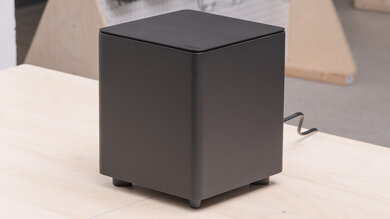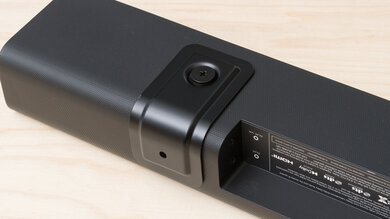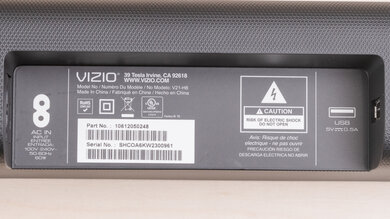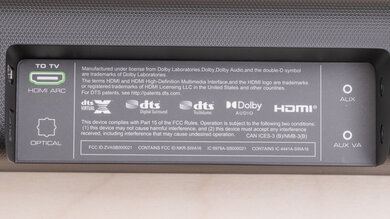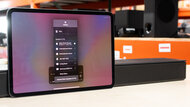The Vizio V Series 2.1 Sound Bar is a 2.1 setup with a dedicated subwoofer. It has a boomy sound profile that's well-suited to listening to bass-heavy music and action-packed TV shows. There's even an HDMI ARC port and a dedicated AUX port for connecting to voice assistant speakers. This bar can get pretty loud, but there's a bit of distortion at max volume. However, as a 2.1 setup, it downmixes surround content into stereo, and it doesn't support Atmos content. That said, it has a few EQ presets and a virtual surround mode, so you have some ability to customize its sound.
Our Verdict
The Vizio V21-H8 is decent for mixed usage. On its 'Music' preset, this soundbar has a bass-heavy sound profile that adds extra boom to your audio. Vocals and lead instruments are reproduced clearly, and you can use its bass and treble adjustments to customize its sound. However, there's no Atmos support, and its surround performance is poor.
-
Gets loud.
-
Four EQ presets.
-
Doesn't support Atmos content.
-
Some distortion at max volume.
The Vizio V21-H8 is good for dialogue-centric content like TV shows. It can reproduce voices clearly and accurately, and there's even a dialogue enhancement mode to make them more clear and crisp. However, due to its 2.1 setup, it has a phantom center, so voices aren't as accurately localized to a pinpoint location in the soundstage.
-
Gets loud.
-
Dialogue enhancement feature.
-
Some distortion at max volume.
The Vizio V21-H8 is satisfactory for music. On its default 'Music' preset, it has a boomy sound profile with extra punch and warmth in the bass range. Vocals and lead instruments are reproduced clearly, though this may be overwhelming for some listeners. Fortunately, there are bass and treble adjustments to help you customize its sound to your liking.
-
Four EQ presets.
-
Some distortion at max volume.
The Vizio V21-H8 is passable for movies. This 2.1 setup has to downmix surround content into stereo to play it, which doesn't sound very immersive. Also, it doesn't support Atmos content. That said, it can get pretty loud, and it can reproduce dialogue quite clearly. The extra boom in the bass helps accentuate action-packed scenes, too.
-
Gets loud.
-
Doesn't support Atmos content.
- 7.0 Mixed Usage
- 7.7 Dialogue/TV Shows
- 7.4 Music
- 6.3 Movies
Changelog
- Updated May 05, 2023: Converted to Test Bench 1.2. Updated the results for audio format support via ARC/eARC, HDMI In, and Optical. Added Video Passthrough to TV results as well.
- Updated Apr 06, 2023: Added cable lengths to In The Box.
- Updated Apr 05, 2023: Converted to Test Bench 1.1. With this update, we've added a Mounting test and added information aboutSubwoofer Output, Spotify Connect, and Microphone Mute.
- Updated Dec 15, 2021: Updated review for accuracy and clarity.
- Updated Feb 18, 2021: Converted to Test Bench 1.0.
Check Price
Differences Between Sizes And Variants
The Vizio V21 soundbar comes in one color variant: Black. You can see the label for the model we tested here. There's also another variant of this soundbar, the Vizio V21-H8R, which has a similar look but comes with a screen on the remote.
If you come across any other variants of this soundbar, let us know in the discussion section below so we can update our review.
Compared To Other Soundbars
The Vizio V21 soundbar is a 2.1 setup from Vizio's 2020 lineup. It's fairly straightforward, but it does have a few sound enhancement features, including four EQ presets and a designated AUX port for a voice assistant speaker. However, unlike some of the more premium soundbars we've tested, it doesn't support Dolby Atmos content, and you can only stream audio to the bar via Bluetooth.
If you're looking for more soundbars, check out our recommendations for the best soundbars under $200, the best soundbars for dialogue, and the best soundbars under $300.
The Vizio V Series V21-H8 is a better soundbar for mixed usage than the Vizio V Series V21x-J8. The V21-H8 has a slightly more balanced sound profile out-of-the-box, and it gets louder with less compression at max volume. Also, it has a better center channel performance. That said, the V21x-J8 has an AUX In port for third-party voice assistant devices, and its sub is a bit smaller.
The Vizio V Series V51-H6 is a better soundbar than the Vizio V Series V21-H8. The V51-H6 is a 5.1 setup that has dedicated satellite speakers, unlike the 2.1 V21-H8. It also has a better-balanced, more neutral sound profile.
The Sonos Arc is better than the Vizio V Series V21-H8. The Sonos is better built and supports Dolby Atmos content and voice assistants. It has better soundstage, center, and surround performances and comes with room correction. However, the Vizio comes with EQ presets, which some listeners may prefer for sound customization.
The Vizio V Series V21-H8 is a better overall soundbar than the Sony HT-S350. The Vizio has a better-balanced sound profile with a lower-extended bass than the Sony, and it also has more sound enhancement features thanks to its bass and treble adjustments. The Vizio also comes with AUX ports, and it supports DTS content, unlike the Sony. However, the Sony is better built and seems a bit more durable.
The Hisense HS2100 and the Vizio V Series V21-H8 are both 2.1 bars with similar strengths. They're similarly sized, and both are decently well-built, with support for Dolby Digital and DTS but not Dolby Atmos. They both have warm default sound profiles that still reproduce dialogue and speech clearly, and both get loud enough to fill a living room with sound. The Vizio has less compression at max volume and allows you to adjust the subwoofer level. Otherwise, both soundbars offer an extremely similar performance, though the Hisense retails for less.
The Vizio M Series M215a-J6 is a better 2.1 bar than the Vizio V Series V21-H8. They're both budget-friendly options, but only the M Series supports Dolby Atmos content. Its default sound is also more balanced out-of-the-box, so you don't notice as much extra boom in the bass. That said, if you don't watch a lot of Atmos movies, you may prefer the more affordable V Series.
Depending on your listening habits, you may prefer either the Vizio V Series V21-H8 or the Samsung HW-B550. They're both 2.1 bars at budget-friendly prices. The Vizio is best for fans of bass-heavy music—it reproduces more low-bass and adds more boom and punch to the mix right out of the box. The Samsung is more balanced out-of-the-box but has more customization tools, like a graphic EQ. You can add more boom in the high-bass with these features, but unfortunately, the Samsung soundbar still doesn't get the rumble in the low-bass like the Vizio.
The Vizio V Series V21-H8 is better than the Vizio SB2020n-J6. The V21-H8 is a 2.1 setup with a dedicated subwoofer that can reproduce a more extended low-bass. It gets louder, and it has a better soundstage performance. Also, whereas the SB2020n-J6 can only support PCM content, the V21-H8 supports surround sound like Dolby Digital and DTS content. That said, if you want an affordable, standalone bar, the SB2020n-J6 is a fair choice for dialogue-centric content.
The Samsung HW-A650 is better than the Vizio V Series V21-H8. The Samsung is a 3.1 setup that's better built with a discrete center channel to help anchor voices in the soundstage. Unlike the Vizio, it also has a Full HDMI In port. Some listeners may also prefer its more neutral sound profile out-of-the-box. That said, the 2.1 Vizio can reproduce a more extended low-bass.
The Samsung HW-A550 is a better soundbar than the Vizio V Series V21-H8. The Samsung is better-built with a more neutral sound profile out-of-the-box, which some users may prefer. Also, it comes with a graphic EQ for sound customization and a Full HDMI In port, unlike the Vizio.
The Samsung HW-A450 is a slightly better soundbar than the Vizio V Series V21-H8. The Samsung has a more neutral sound profile out-of-the-box, which some users may prefer, it can reach its max volume with fewer compression artifacts, and it has a graphic EQ so that you can customize its sound. However, the Vizio is better built, offers more inputs such as an HDMI ARC port, offers a better surround performance.
The Vizio V Series V21-H8 is a better soundbar than the Vizio M-Series M21d-H8R. The V Series has a more neutral sound profile and a better soundstage performance. Also, it gets louder with much less compression at max volume. However, the M-Series is better-built, and it has a Full HDMI In port that supports 4k passthrough.
The Vizio V Series V21-H8 is a bit better for mixed usage than the TCL Alto 8i. The Vizio has a dedicated subwoofer that can reproduce a more extended low-bass. It also comes with more sound enhancement features, like dialogue enhancement. However, it doesn't support Dolby Atmos content like the TCL. Some listeners may also prefer the TCL's standalone design.
The Vizio V Series V21-H8 is a better soundbar for music and movies than the TCL Alto 6+. The Vizio can produce a thumpier, boomy sound, and its center, as well as surround performances, are better. It offers more sound enhancement features.
The Sony HT-S200F and the Vizio V Series V21-H8 are similar 2.1 soundbars, so depending on your listening habits, you may prefer one over the other. The Vizio has a dedicated subwoofer, unlike the Sony, so it has a more extended bass. It also has more sound enhancement features. However, the Sony has less compression at max volume, so it's better-suited for use in loud parties.
The Vizio SB36512-F6 is a better soundbar than the Vizio V Series V21-H8. The 5.1.2 SB36512-F6 has a better-balanced sound profile that's suited for an even wider array of audio content. It also has discrete surround speakers, and it supports Atmos content, unlike the 2.1 V Series. It also more connectivity options and is compatible with more wireless playback options, like Chromecast and Wi-Fi. It can also be controlled via its companion app. That said, the V Series comes with a dialogue enhancement feature, which the SB36512-F6 lacks.
The Vizio V Series V21-H8 is a somewhat better overall soundbar than the Samsung HW-T450. The Vizio is better-built, and it comes with more connectivity options, including an HDMI ARC port and two AUX ports. It also has more sound enhancement features, including dialogue enhancement. That said, the Samsung has less compression at max volume, so it may be better suited for use during loud parties.
The Samsung HW-T550 is a better 2.1 soundbar than the Vizio V Series V21-H8. The Samsung is better-built, and it has a more neutral, less boomy sound profile. It also comes with a graphic EQ so you can customize its sound and a Full HDMI In port so you can use it as a hub between your devices. That said, the Vizio has less distortion when it's played at max volume, so it may be a better option for use at loud parties.
Test Results
If you're looking for a setup with dedicated satellite speakers, check out the Vizio V Series V51-H6.
The subwoofer is about the same width as an average desktop PC, but unlike many other soundbars with an external subwoofer such as the TCL Alto 6+, it's also fairly short. It connects wirelessly to the bar, so you can place it anywhere in your room as long as it can connect to a power source.
The Vizio V21-H8 has a decent build quality. The sides of the subwoofer are made of melamine, while the top is made of plastic. The bar itself is mostly made of plastic, which feels solid and durable. However, the fabric covering the front and sides of the bar seems like it could get dirty or rip easily. For a better-built soundbar, check out the Vizio M-Series M21d-H8R or the Samsung HW-A550.
The Vizio V21 has a good stereo frequency response. On its 'Music' preset, it has a boomy sound profile due to the overemphasized bass range. Vocals and lead instruments are reproduced clearly and accurately, but you notice extra punch and warmth in your audio, which can be overwhelming for some users. There are also some bass and treble adjustments to help you customize its sound.
With calibration, the Vizio V Series V21-H8 has a good stereo frequency response. It has a more neutral, balanced sound profile with its bass set to '-4'. There's still a little extra punch in the bass range, though. That said, it's suitable for listening to lots of different types of audio content.
The Vizio V21 has a satisfactory stereo soundstage. It sounds about as wide as the bar itself, but the bar doesn't have any tricks to make it sound wider than that. Its focus is okay, so objects like voices and instruments seem to come from an accurate, pinpoint location rather than a general area.
This soundbar has good stereo dynamics. It can get louder than the Vizio V Series V21x-J8, but there's a bit of compression when you play it at max volume, especially in the bass range, so audio reproduction isn't as clear.
This soundbar has a good stereo total harmonic distortion performance. At normal listening volumes, the bar produces a clean and pure sound. There's a bit of a jump in THD at max volume, but it may not be audible with real-life content.
The Vizio V21-H8 has an acceptable center channel performance. Due to its 2.1 configuration, it has to use its left and right channels to simulate a phantom center. This doesn't sound as clear or as real as discrete localization, though. You may notice that voices aren't accurately anchored to a pinpoint location in the soundstage.
This soundbar has a poor surrounds performance. It has to downmix surround content into stereo, which doesn't sound as clear and accurate as a home theater setup. Surround objects seem like they're coming from in front of you rather than all around you.
The Vizio V21 has an adequate selection of sound enhancement features. You can customize its sound using its bass and treble adjustments as well as its EQ presets, including 'Movie', 'Music', 'Dialogue', and 'Game'. You can even use the TVOL button on the remote to activate the night mode feature when watching TV at night. However, it lacks premium sound enhancement features, such as a graphic EQ and room correction.
The Vizio V21-H8 has several inputs. There are two AUX ports: one for analog audio and one for a voice assistant speaker only. You can connect it to your TV via ARC or Optical In. However, there isn't a Full HDMI In, so you can't use the soundbar as a hub between your devices.
The Vizio V21-H8 supports Dolby Digital and DTS content over its ARC port, and these formats are found commonly on Blu-ray discs and streaming platforms like Netflix and Hulu. However, it doesn't support higher-end formats like Dolby Atmos.
The Vizio V21-H8 supports Dolby Digital and DTS content via Optical Audio In, but it's downmixed to 2.1.
The Vizio V21-H8 has a great latency performance. It has fairly low latency, so the audio you hear is in sync with the video you see on the screen. As a result, it's a solid choice for watching videos and movies. Some apps and TVs compensate for latency differently, so your real-world experience can vary.
This soundbar doesn't have an HDMI In port, so it doesn't support video passthrough.
The Vizio V21 has acceptable wireless playback connectivity options. You can use Bluetooth to stream audio wirelessly to the bar. The bar lacks other wireless connections that could make it more versatile.
This soundbar doesn't have built-in voice assistant support. However, the manufacturer says that you can use it with Alexa, Google Assistant, and Siri if you connect a third-party voice assistant device via the designated AUX port. Vizio also says that you can pair a voice assistant device to the bar via Bluetooth.
Comments
Vizio V Series V21-H8: Main Discussion
Let us know why you want us to review the product here, or encourage others to vote for this product.
- 21010
What is the recommended sub setting? Should I enable Virtual X or TruVolume?
Hello Punisher1_1995, You can find this info in the “Stereo Frequency Response With Preliminary Calibration” section of our review. We suggest a bass setting of -4 and leaving the subwoofer level at the default setting. Bear in mind that the calibration values are specific to our testing room, and your preference or room may differ. Enabling DTS Virtual X is a personal preference as well. It will simulate the effects of surround sound, and can provide an enjoyable experience for some content. It can nevertheless sound unnatural on some content. TruVolume can help with annoyingly loud commercials, for example, if that’s an issue distracting you. If your intention is optimal dynamic performance, however, then I suggest not enabling it. Have fun!
- 21010
What is the recommended sub setting? Should I enable Virtual X or TruVolume?
Edited 8 months ago: further clarification Update: Converted to Test Bench 1.2. Updated the results for audio format support via ARC/eARC, HDMI In, and Optical. Added Video Passthrough to TV results as well.



